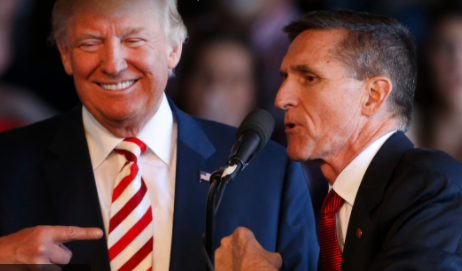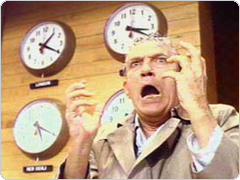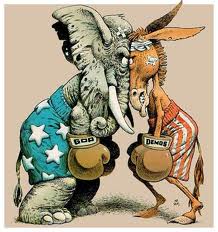 In the 21st century, journalism reflected the growing gap between liberals and conservatives, partly because of 1986 alterations in federal rules regarding fairness and evenhanded reporting, mentioned in the previous chapter. Airwaves were filled with more opinion-oriented commentary, as opposed to what came to be called “straight news.” That change, in turn, coincided with the proliferation of cable TV, satellite radio, and the Internet, giving viewers, listeners and surfers more options to pick from. Commentators endorsed a more confrontational, take-no-prisoners approach to politics as listeners, readers and viewers chose from a buffet offering of partisan print, radio, cable TV, and websites.
In the 21st century, journalism reflected the growing gap between liberals and conservatives, partly because of 1986 alterations in federal rules regarding fairness and evenhanded reporting, mentioned in the previous chapter. Airwaves were filled with more opinion-oriented commentary, as opposed to what came to be called “straight news.” That change, in turn, coincided with the proliferation of cable TV, satellite radio, and the Internet, giving viewers, listeners and surfers more options to pick from. Commentators endorsed a more confrontational, take-no-prisoners approach to politics as listeners, readers and viewers chose from a buffet offering of partisan print, radio, cable TV, and websites.
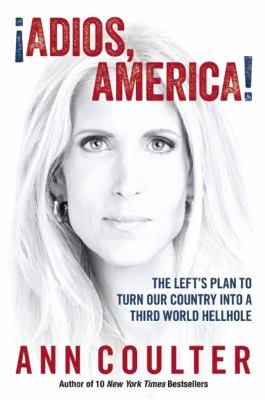 Best-seller lists included books with titles like Anne Coulter’s Demonized: How The Liberal Mob Is Endangering America, or Glenn Beck’s Arguing With Idiots, echoing Gingrich’s memo. Democrats nodded smugly when they heard Prairie Home Companion’s Garrison Keillor explain that “Liberals stand for tolerance, magnanimity, community spirit, the defense of the weak against the powerful, love of learning, freedom of belief, art and poetry, city life, the very things that make America worth dying for…Conservatives stand for tax cuts [and] to use the refund to buy a gun and an attack dog to take with you when you drive your all-terrain vehicle through the barricades of Republicanville.” Republicans could gain a deeper understanding of their own greatness in Peter Schweitzer’s Makers & Takers: Why Conservatives Work Harder, Feel Happier, Have Closer Families, Take Fewer Drugs, Give More Generously, Value Honesty More, Are Less Materialistic and Envious, Whine Less…And Even Hug Their Children More Than Liberals. While such media and literature fell short of mind expansion or encouraging the useful dialog essential to democracy, its purveyors profited by catering to the natural human inclination to read, watch and listen to things one already agrees with. A spirited debate over who volunteered more or gave most to charity was at least a good sign that conservatives and liberals were competing to do good things.
Best-seller lists included books with titles like Anne Coulter’s Demonized: How The Liberal Mob Is Endangering America, or Glenn Beck’s Arguing With Idiots, echoing Gingrich’s memo. Democrats nodded smugly when they heard Prairie Home Companion’s Garrison Keillor explain that “Liberals stand for tolerance, magnanimity, community spirit, the defense of the weak against the powerful, love of learning, freedom of belief, art and poetry, city life, the very things that make America worth dying for…Conservatives stand for tax cuts [and] to use the refund to buy a gun and an attack dog to take with you when you drive your all-terrain vehicle through the barricades of Republicanville.” Republicans could gain a deeper understanding of their own greatness in Peter Schweitzer’s Makers & Takers: Why Conservatives Work Harder, Feel Happier, Have Closer Families, Take Fewer Drugs, Give More Generously, Value Honesty More, Are Less Materialistic and Envious, Whine Less…And Even Hug Their Children More Than Liberals. While such media and literature fell short of mind expansion or encouraging the useful dialog essential to democracy, its purveyors profited by catering to the natural human inclination to read, watch and listen to things one already agrees with. A spirited debate over who volunteered more or gave most to charity was at least a good sign that conservatives and liberals were competing to do good things.
By 2015, enough white Texans feared that half-black president Barack Obama was plotting a military takeover of their state, that Governor Greg Abbott deployed state guard troops to monitor a joint Navy SEAL/Green Beret training exercise (the Pentagon assured them otherwise). When a state governor really thinks that the U.S. president is going use special forces to invade his state, we’ve got a serious communication problem. On both right and left, paranoia, half-baked conspiracy theories, oversimplified stereotypes and false dichotomies were perennial cash cows, wasting time and displacing constructive debate. Journalist Michael Bourne wrote that Americans searching for solid information or historical interpretation: “[were] thrown headlong into a clangorous scrum of cable-news shouters, hashtag revolutionaries, and online conspiracy theorists.”
Liberals turned to HBO’s Bill Maher, MSNBC (owned by NBC and Microsoft), the Daily Kos, Huffington Post (aka “Huff-Po”), Jon Stewart’s Daily Show, and John Oliver’s This Week Tonight, while conservatives got their version of reality mainly from Roger Ailes’ FOX, Newsmax, Breitbart (Andrew Breitbart ironically helped launch the Huffington Post), the Drudge Report, and right-wing radio hosts like Limbaugh or Michael Savage. FOX pushed the ideas that white men were under attack, Christians were being persecuted, Barack Obama hated white people, Margaret Sanger started Planned Parenthood to murder black people, etc. Liberals favored the more mainstream/left-leaning CNN, New York Times, and Washington Post more than conservatives did. Each side mostly inhabited its own hermetically sealed echo chamber. New York Times writer Sam Tanenhaus wrote of the tribes that, “each has its own political party, its own cable-news sermonizers, its own digital oracles, scandal-mongers and data miners, its own billionaire donors and advocacy groups, its own economists and corps of scientific experts…we are left with ritualized conflict, staged and restaged.” The Times itself was no longer a “paper of record” as conservatives like Supreme Court Justice Antonin Scalia boycotted what they saw as its liberal bias. Budding citizens should take a look at the Times’ “Room For Debate” columns before deciding that for themselves, as they feature well-known conservative commentators.
This PEW poll shows where people turned for information as of 2014. For awhile, Air America tried to counter right-wing radio, featuring comedian Al Franken, who went on to become a senator from Minnesota, but that didn’t last. Conservatives, it seemed, did better on the radio, while both sides indulged in blogs, posts, and memes. Online sources sold advertisements to clients by offering outrageous clickbait. Blogs and chat rooms filled with vulgarity and cheap shots — “blogorhhea” in “blargon” — as trolls took advantage of their anonymity to be inconsiderate creeps toward their fellow human beings. By the mid-2010s, an even bigger problem was outright falsehoods and hoaxes. Americans collectively hadn’t become the uninformed citizenry that founders like Jefferson worried about so much as a misinformed citizenry, which might be even worse. This image, for instance, made the rounds on liberal emails and Facebook® posts:
However, according to Snopes, Trump either never said that or at least it’s nowhere to be seen in People Magazine’s archives. Yet, “the Donald” took advantage of these loose standards himself spreading all sorts of misinformation, leading rival candidate Ted Cruz (R) of Texas to call him a “pathological liar” and overloading the Truth-o-Meter machine on the Pulitzer-prize winning fact-checking site Politifact. When CNN confronted Trump about one false rumor that he retold on the campaign trail about a man connected to ISIS rushing his stage, he said, “What do I know about it? I’ll I know is what’s on the Internet.” When Fox News’ Bill O’Reilly confronted Trump about his Tweet stating that 81% of Whites murdered are killed by Blacks, pointing out that the real number is 15%, he replied, “Bill, am I going to check every statistic? …This came out of radio shows and everything else.” Liberal author Paul Horner fed Trump supporters fake news during the 2016 campaign as a joke, but it backfired and helped Trump. He hoped they’d post them then look silly later after somebody fact-checked, but no one ever checked. Horner said, “when people [finally] checked later and the things he said turned out not to be true, people didn’t care because they’d already accepted it. It’s real scary. I’ve never seen anything like it.” At least Horner got paid well for his stories.
Former New York Senator Daniel Patrick Moynihan once said that “every man has a right to own opinion, but no man has a right to be wrong in his facts.” Such sentiment seemed out of date by the early 21st century, when everyone had a right to his or her own opinion and facts. At the 2016 GOP convention, a CNN reporter asked Newt Gingrich how Trump could argue that crime rose under Barack Obama when FBI statistics clearly show it fell. Gingrich replied that “While that’s true in theory (i.e. fact), people feel that it rose and it’s a fact that it’s my opinion.” Shortly after the election, Trump supporter and CNN reporter Scottie Nell Hughes proclaimed to NPR: “There are no such things as facts.”
In the 2016 election, studies showed the prevalence of hoaxes in the news cycle, especially given that many American adults get their news from social media like Twitter® and Facebook®. According to BuzzFeed, fake news stories outperformed real news by a considerable margin on social media in 2016. Millions of conservatives, for instance, learned that the Pope endorsed Trump, while liberals gushed at news that Barbara Bush said “no woman would ever vote for Trump.” Neither ever happened and nor did Hillary Clinton sell weapons to ISIS. On election day, former New York mayor Rudy Giuliani didn’t Tweet that conservatives need to vote to prevent Blacks and Hispanics from stealing the election. Media scholar Siva Vaidyanathan described how, in order to keep selling ads by keeping you reading, Facebook’s® algorithm gradually skewed your news sources toward whatever you’d shown that you “liked” or opened up in the past — in other words, the collective political leanings of your friends created your “filter bubble.”
By 2016, Addicting Info on the left and Freedom Daily on the right trafficked mainly in hoaxes, raking in dollars on the insight that citizens are more interested in political fantasy than reality. Infowars, run by former ACC student Alex Jones, argued that the government can create and control tornadoes, that the Sandy Hook massacre was fake (performed by actors), and that tap water is a “gay bomb.” Jones said, “it is surreal to talk about issues here on air and then word for word hear Trump say it two days later.” If boredom kept most people from following politics, perhaps making it more like a game show or pro wrestling match could help. One thing that was honest, though, about Addicting Info was their motto: “the knowledge you crave.” Freedom Daily touted its “daily dose of freedom,” likening conservative hoaxes to drug addiction. The good news is that readers didn’t have to struggle through tedious passages like the ones I presented above on healthcare or the financial crisis; the bad news is their heads were mainly full of the stuff Bess Truman spent thirty years trying to convince Harry to call “fertilizer.” Obviously, this caused distortion among the electorate regarding issues that would’ve already been complicated enough even if they’d had the fortitude to confront reality. In the cacophony of “free speech” voices, many American citizens weren’t as well informed as those living under dictatorships who knew propaganda when they heard it.
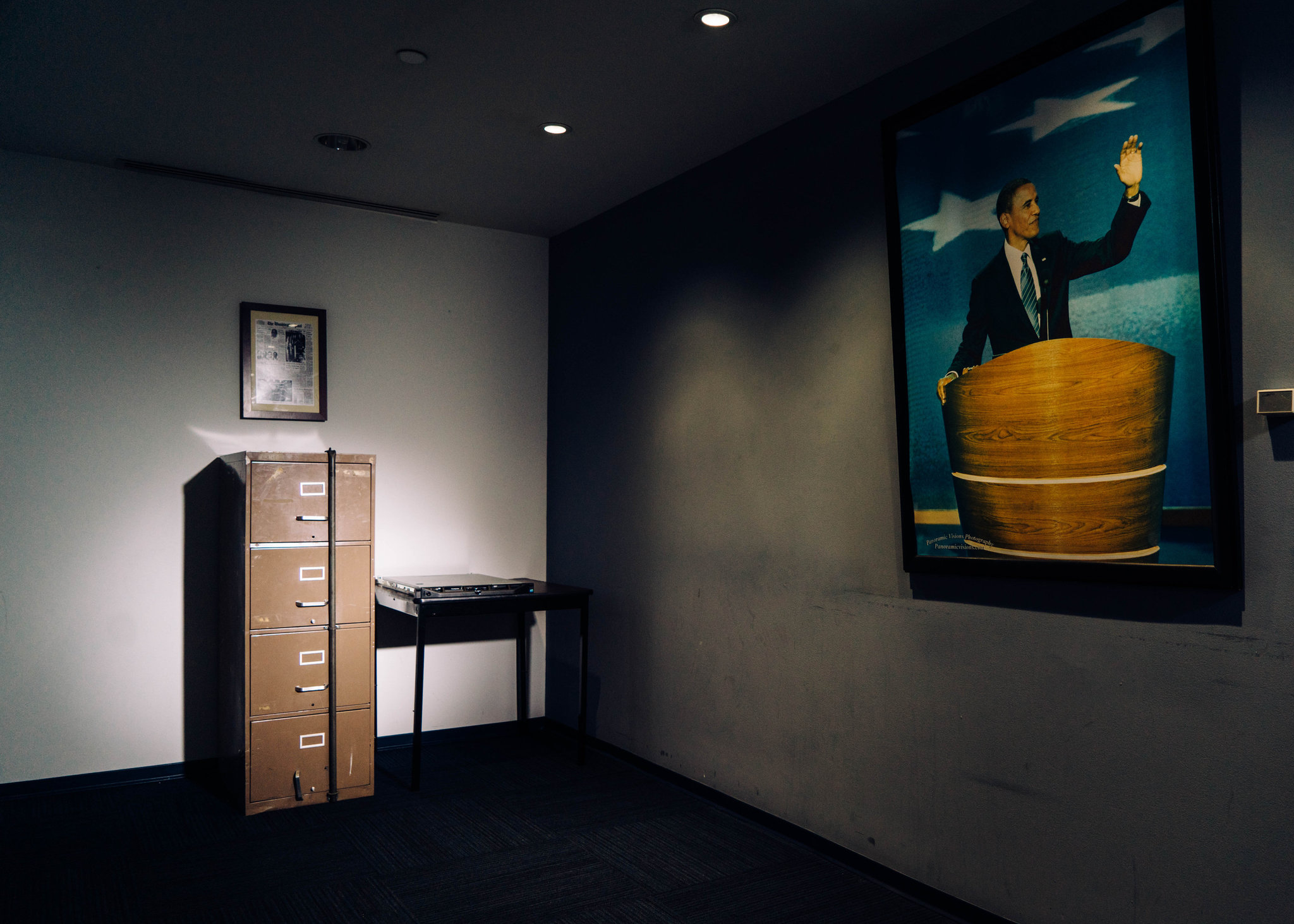
Cabinet From Watergate Break-In of 1972 Next to Democratic National Committee’s Hacked Email Server From 2016, Justin Gellerson, New York Times
However, dictatorships also use cyber-power against democracies, as American intelligence detected a familiar pattern of Vladimir Putin’s Russia dumping rumors, compromising classified correspondence, and even fake news into elections in the U.S., England, France and Germany via outlets like WikiLeaks and Sputnik News, hoping to sow as much chaos and distrust of democratic institutions as possible by making it impossible for voters to distinguish between fact and fiction (see “How Russia Wins An Election,” by Clint Watts & Andrew Weisburd, Politico Magazine, 12.13.16). China, too, wormed their way into both the Obama and John McCain campaigns in 2008, gaining access to position papers and communication, but never published their findings. In the 2016 Election, Russia hacked into both party’s campaign files, but only published emails from the Democrats. According to the New York Times, Russia’s capacity to directly influence fake news is much stronger in Europe than within the United States, though some of the American variety is authored in Eastern Europe. More influential on America’s 2016 election was pro-Putin Briton James Dowson. Dowson saw his role as similar to the Breitbart’s role in Brexit (Britain’s exit from the European Union).
 It’s not just voters that are confused. The son of Trump’s first National Security Adviser, Michael Flynn (D) — the position that coordinates policy between the Pentagon, CIA, NSA, Department of Homeland Security and State Department in the event of a crisis — Tweeted that Hillary Clinton was involved in a Satanic cult and operated a child sex ring out of a Washington pizza parlor. Flynn, Sr. didn’t disavow the views himself and thought Barack Obama was a “jihadi” who laundered money for Muslim terrorists. If people were surprised in early December 2016 to find a crazed gunman (right) travel to D.C. to bust into the pizza parlor and investigate “#pizzagate” (the story about Hillary’s imaginary pedophilia ring), those that hadn’t been following recent media trends were even more surprised to find that the president-elect’s adviser and family were indulging the rumor launched on Reddit® and 4Chan®. Trump fired Mike, Jr. from the transition team the next day.
It’s not just voters that are confused. The son of Trump’s first National Security Adviser, Michael Flynn (D) — the position that coordinates policy between the Pentagon, CIA, NSA, Department of Homeland Security and State Department in the event of a crisis — Tweeted that Hillary Clinton was involved in a Satanic cult and operated a child sex ring out of a Washington pizza parlor. Flynn, Sr. didn’t disavow the views himself and thought Barack Obama was a “jihadi” who laundered money for Muslim terrorists. If people were surprised in early December 2016 to find a crazed gunman (right) travel to D.C. to bust into the pizza parlor and investigate “#pizzagate” (the story about Hillary’s imaginary pedophilia ring), those that hadn’t been following recent media trends were even more surprised to find that the president-elect’s adviser and family were indulging the rumor launched on Reddit® and 4Chan®. Trump fired Mike, Jr. from the transition team the next day.
In some ways, the more fragmented media fulfilled the prophetic vision of the 1976 classic Network, in which the outraged, end-of-his-rope news anchor Howard Beale cuts loose on anti-society and anti-establishment rampages that only please corporate executives because they improve ratings. Beale ends up getting his dedicated (and paying) audience to chant his signature phrase, I’m as mad as hell, and I’m not going to take this anymore! By the early 21st century, Howard Beales were all over cable and radio, as mad as hell at everything under the Sun. They were an establishment in their own right, more entrenched and annoying than whatever it was they were complaining about.
In 2016, the executive chair of Breitbart, Steve Bannon — an outspoken Alt-right critic of liberals, mainstream Republicans, and political correctness who called progressive women “a bunch of dykes” — was named president-elect Donald Trump’s chief strategist. The American Nazi party proclaimed that “Trump might be for real” and former KKK Imperial Wizard David Duke called the choice “excellent,” since Bannon “was basically creating the ideological aspects of where we’re going.” Those voices, no doubt, aren’t ones Bannon and Trump want to be associated with, but their endorsements underscore the extremism some people interpret (or misinterpret) from “non-liberal media elite” sites like Breitbart in the age of hyper-partisanship. Even the center/right Wall Street Journal associated Bannon with unsavory “white identity grievance politics.” While there’s little evidence for Bannon’s supposed anti-Semitism and racism, his rage against globalization resonates with the America-first economic nationalism of Tea Partiers and he purportedly told conservative historian Ronald Radosh that hoped to “bring everything crashing down.”
Many Americans got familiar with Trump not as a real estate mogul but as a reality show host (The Apprentice) and, as Bannon’s rise showed, media could not only impact elections but also reward the journalists themselves by putting them in power. Bannon’s actual content probably wasn’t as important as his the sense of righteous indignation. People were frustrated at their powerlessness in a complicated and changing world and mad at each other and a good ranting attracted viewers. Journalist James Fallows documented that many of these people were relatively happy with the local situation around them “on the ground” wherever they lived in America. Their attitudes about the country overall belied this optimism, though, as they found themselves sucked into a media vortex likes moths to a light. Like our fictional Howard Beale on TV, Bannon yelled the loudest on the Internet, except that in the non-fictional version the yeller landed in the White House, illustrating that often “truth [really is] is stranger than fiction.” Comedian John Oliver pointed out that “weird conspiracy b.s. has always been bubbling under the surface, but Trump was the first major candidate to harness and fully legitimize it.” Trump launched his campaign with the Birther Movement, based on the unsubstantiated idea that Barack Obama was born in Kenya. What good reason was there to suspect that Obama wasn’t American? None, but if you were white enough, this fake news might’ve been a “dose of what you craved.” Conservatives Glenn Beck and radio host Charlie Sykes had seen enough by 2016 and jumped ship, lamenting their role in the Birther Movement and rise of “shoutrageous” hyper-partisanship, but Bannon was rewarded with a powerful role in the White House, even slipping himself into a role on the National Security Council.
With GOP control of all three branches by early 2017, FOX became the de facto state news channel. Once he became president, Trump flipped the script on the fake news complaint and labeled any mainstream/near-left news fake that called him out on his claims. At a Trump press conference, a Breitbart reporter asked about potential regulatory reform to silence fake news sites like CNN. By then, true fake news (if you pardon an oxymoron) was proliferating more than ever on the far left. By 2017, already divided Americans were struggling to figure out whom to trust for their information. This doesn’t bode well for the future of the republic if there’s no agreed-upon journalistic center of gravity. Here is actor Vanessa Otero’s take on the political leanings and quality of journalism along x-y axes circa 2016.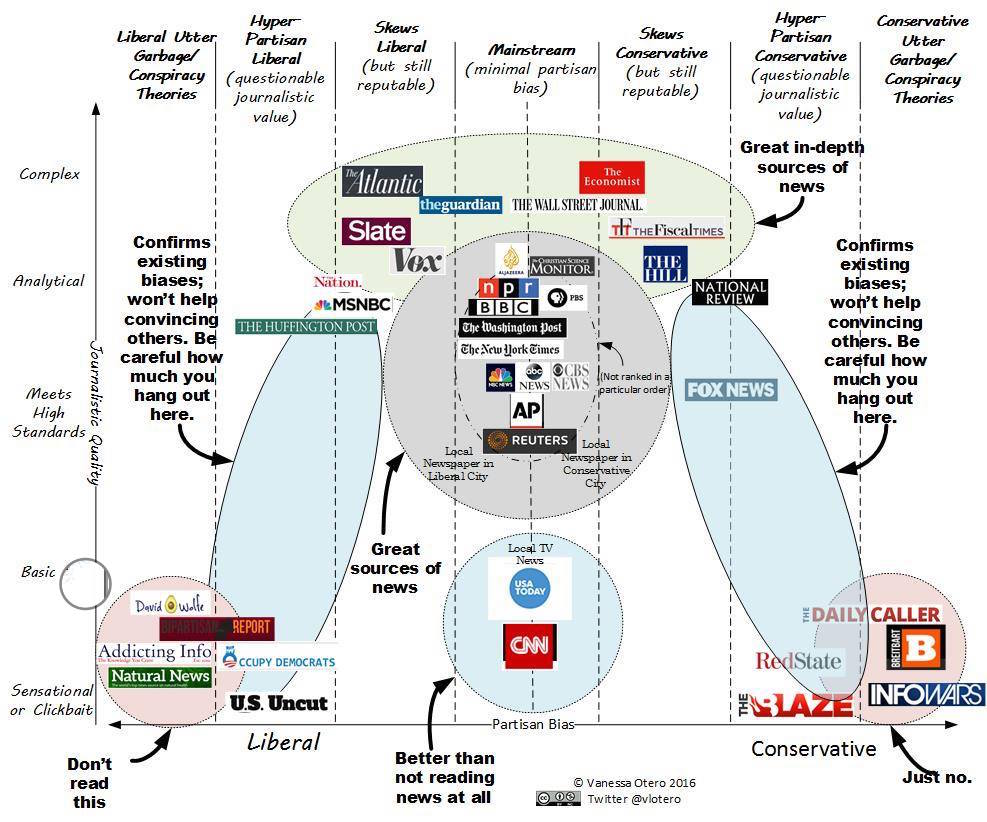
If you’re like many Americans, you’ll disagree with the chart because you’ll find it simplistic and too far to the left or right, and you needn’t agree with it; it’s not official or comprehensive. But, for the sake our country’s future, considering stepping back and informing yourself across a range of sources. It’s essential to the health of our republic that we get more media savvy. If you’re interested in what leaders like Barack Obama or Donald Trump have really said, listen to them directly. If you’re interested in what Margaret Sanger thought, read her online papers in context. If you’re interested in what’s going on at the Veteran’s Administration, go to the VA website, etc. The sources on the lower right and lower left in the chart above have every right to exist and you have the right to read and enjoy them, but as a citizen and voter don’t confuse them with real news. Consider giving these modern forms of Yellow Journalism a break for awhile and figure out what’s actually happening. Without that effort, we’ll be increasingly subject to the sort of rumors exemplified by the claim that 3 million illegal aliens in California voted for Hillary Clinton. Why did people think that? One random man Tweeted it, Infowars printed it, and Trump repeated it. Shortly after, a CNN reporter asked a woman why she thought that and she replied “the media told me.” When called out by a reporter from ABC News for his unsubstantiated claim, Trump said, “You know what’s important? Millions of people believe me, and these are very smart people.” White House spokesman said “It’s something he believes and he believes what he believes based on the information he’s provided.”
Media isn’t just more splintered along a wider spectrum; the more media there is the more outrageous outlets have to be to attract readers/viewers/listeners. What advertiser would pay for a boring show arguing that most people agree on most things and that there aren’t any conspiracies to take over the world that we need to worry about? Whose thumb wouldn’t instantly hit the up or down channel button when there’s a compelling playoff game, drama, or reality show on another channel? Who would place ads if I started a website arguing that most conspiracies aren’t real and that Hillary Clinton and Barack Obama don’t actually emit a sulfuric odor because they aren’t actually possessed by demons, as promoted by Alex Jones on Infowars? I’d go out of business on the first day for lack of clickbait. Likewise, the established newspapers and outlets of yesteryear are going out of business as aggregates pass around free content and we forward that to friends and family on social media. In the meantime, there’s no one to pay real journalists to perform the Fourth Estate tasks essential to a functioning republic.
More Back-Up
The dirtiest politics often occurs in the presidential primary phase, not just the general election. In 2016, Donald Trump trashed Vietnam veteran John McCain (R-AZ) for being captured and the GOP candidates indirectly debated the size of one another’s respective genitals, while Bernie Sanders’ supporters complained of Democratic party operatives rigging their primary election in Hillary Clinton’s favor. In the general election, social media filled with spurious accusations, with anti-Clinton posts and click-bait authored by (Vladimir) Putinists in Russia and Eastern Europe and a false claim that Trump told People magazine in 1998 that Republican voters were dumb (Snopes). Based on reports that originated on social media and migrated to Info-Wars and Breitbart, a gunman broke into a Washington, D.C. pizza joint to break up a purported child sex-slave ring Democrats were running out of the basement. Among other things, Pizzagate demonstrated that we’ve lowered our mainstream standards in thinking seriously about reality.
Memory Hole:
How Pronounced Is White Privilege in the U.S. Today? Peggy McIntosh & Shelby Steele
